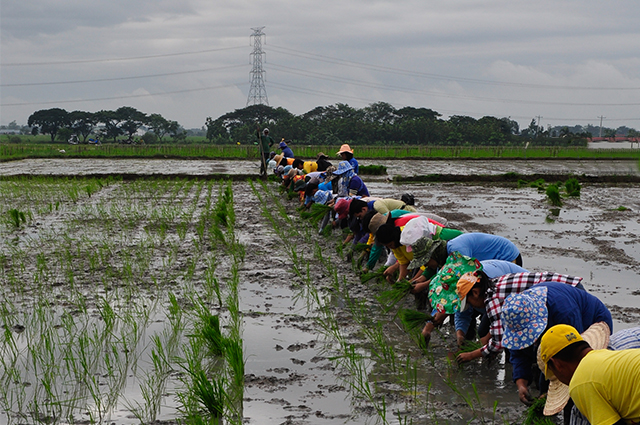 Experts at PhilRice alert farmers to prepare for the rainy season by using appropriate varieties and technologies in rice farming.
Experts at PhilRice alert farmers to prepare for the rainy season by using appropriate varieties and technologies in rice farming.
Dr. Norvie Manigbas, head of PhilRice’s Plant Breeding and Biotechnology Division, advised farmers to plant varieties which stand at most 100 cm and with strong stems that can withstand 40-60 kph wind speed.
Some of these varieties are PSB Rc14, Rc68, NSIC Rc9, and Rc222.
“Rainfed areas are also prone to flooding. The varieties suited for this condition are PSB Rc18 (Ala), which can withstand 5-7 days of complete submergence, NSIC Rc194 (Submarino 1), which can survive, grow, and develop even after 10-14 days of complete submergence, and PSB Rc68 (Sacobia), a submergence-tolerant and a drought-resistant variety,” Manigbas said.
These varieties have the following maximum yield: 8.1 t/ha (RC18); 3.5 t/ha (Rc194); 4.4 t/ha (Rc68); 6.1 t/ha (Rc14); and 10 t/ha (Rc222).They can also recover when submerged during vegetative stage.
“These are the maximum yields that the farmers could get under stressed conditions,” Manigbas said.
Additionally, PhilRice also emphasizes reduction of fertilizer application rates. Manigbas reminded that while fertilizers are beneficial to plants, in high amounts, they may cause lodging.
“Fertilizers cannot be maximized, as there is a limited amount of sunlight during the rainy season. Depending on soil analysis results and recommended nutrient requirement rates, it is better to reduce fertilizer application rates by 20-30% in wet season,” Manigbas explained.
Technologies
Under rainfed conditions, Manigbas encouraged farmers to practice synchronous planting in their communities. It reduces incidence of pests and diseases in a specific area, thus minimizing yield loss.
Dry land preparation is also desired so farmers can do direct-seeding when the rain comes. With this technique, the seeds will start to germinate within 5 days.
Manigbas explained that under irrigated lowland conditions, land preparation should be done at the onset of heavy rains so that fields are well-soaked in water. Levees and dikes should be repaired to avoid water loss.
Farmers can use the wet bed or dapog method for seed establishment depending on field conditions. PhilRice also suggests proper drainage to avoid flooding, use of machines during land preparation, harvesting, threshing, and drying to save time and labor.
“Time is vital during the wet season especially during harvest. As the rain usually comes in the afternoon, we suggest the use of combine harvester to hasten harvesting operations. If it is unavailable, farmers can use reaper and collect the straws for threshing,” Manigbas explained.
He emphasized the importance of finishing field operations in the shortest possible time to prevent yield loss.
PhilRice also recommends drying of palay in flatbed dryers and on nylon nets or canvas for easier turnover when the rain comes.
“The general rule is to harvest and thresh the crop within a short period of time and dry the seeds to a desired moisture content (usually 14%),” Manigbas concluded.
For more information on rice varieties and technologies for wet season, please contact the PhilRice Text Center at 0917-111-7423.




